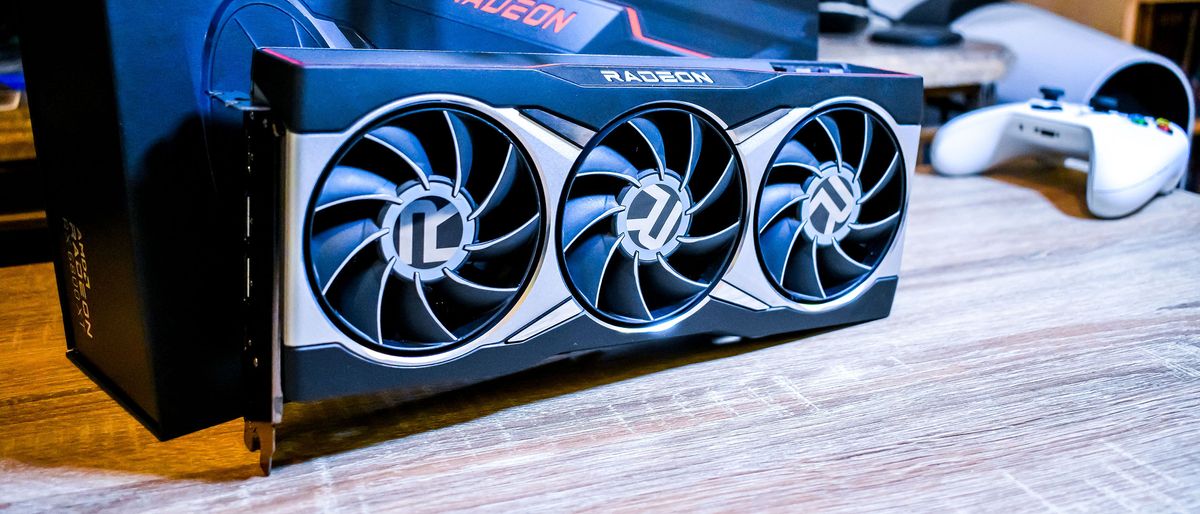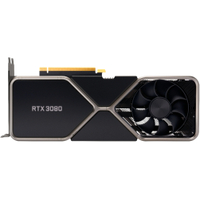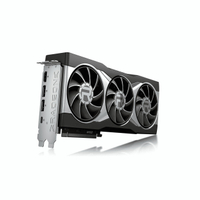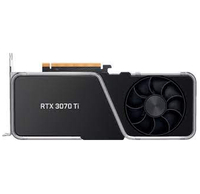TechRadar Verdict
The AMD Radeon RX 6800 XT is AMD's first graphics card in years that actually challenges Nvidia at the high-end. However, the performance here doesn't knock Nvidia off its throne, especially in modern DX12 games.
Pros
- +
Ray tracing for AMD
- +
Meaningful challenge to Nvidia
- +
Strong DX11 performance
- +
Effective cooler
Cons
- -
Doesn't dethrone Nvidia
- -
Disappointing ray tracing performance
- -
Divisive card design
Why you can trust TechRadar
AMD Radeon RX 6800 XT: Thirty second review
The AMD Radeon RX 6800 XT is AMD’s big comeback to the high-end GPU market. This impressive graphics card is even taking on Nvidia’s GeForce RTX 3080 with matching performance, doing better in some games – like Resident Evil Village at 1440p without ray tracing on – while worse in others, while offering a slightly more attractive price tag.
Finally, AMD now has a viable and more appealing alternative on its hands to Nvidia’s heavy hitter and its absolutely one of the best AMD graphics cards ever made.
With the new AMD Radeon RX 6800 XT, gamers are getting 4K gaming power as well as advanced features like ray tracing for $649 (about £649, AU$960). It means a more affordable 4K gaming option for those who want to save a few bucks.
It also means choosing the best graphics card for 4K gaming hasn’t been this hard since 4K gaming first came onto the scene. It might not dethrone Nvidia, but we also expect a lot of gamers, especially the more budget-conscious, to lean towards the AMD Radeon RX 6800 XT.
AMD Radeon RX 6800 XT: Price and availability
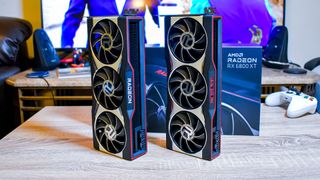
- Starting MSRP is cheaper than rival RTX 3080
- AMD Radeon RX 6800 offers a more compelling value
The AMD Radeon RX 6800 XT is available now, starting at $649 (around £649, AU$960), with the price going up from there for aftermarket versions of the graphics card. This is slightly under the $699 (£649, about AU$960) Nvidia GeForce RTX 3080.
What sours this price point for the AMD Radeon RX 6800 XT, however, is the lower-end RX 6800, which is just a tad slower, but comes at a lower $579 (about £440, AU$800) price tag. You're paying 12% more for a graphics card that is between 5-10% faster – that math doesn't add up.
This makes it hard to recommend the Radeon RX 6800 XT from a sheer value perspective. Either that, or it just makes the Radeon RX 6800 look way more valuable – which is exactly what happened with the RX 5700 XT and RX 5700 when those cards launched back in July 2019.
Most of all, this is a huge jump for a flagship AMD card in terms of price. AMD used to be known for making the best cheap graphics cards around by offering solid performance at a compelling price. It looks like those days are gone, as the RX 6800 XT barely competes with the RTX 3080 in terms of its cost.
- Value: 3 / 5
AMD Radeon RX 6800 XT: Features and chipset
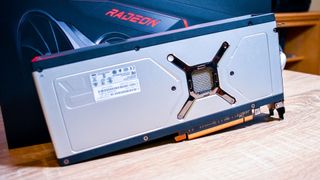
- Radeon finally gets ray tracing
- No tensor cores
- Much faster clock speeds than RTX 3080
The AMD Radeon RX 6800 XT is based on Team Red's RDNA 2 graphics architecture, which is still based on a 7nm (nanometer) manufacturing process. Rather than shrinking the die, AMD has worked in some new features and boosted efficiency, which makes these graphics cards way more powerful than their predecessors.
The biggest of these is the new Infinity Cache, which is crucial when you consider that the Radeon RX 6800 XT is using 16GB of GDDR6 memory, rather than the GDDR6X memory found on the Nvidia GeForce RTX 3080 and RTX 3090.
The Infinity Cache is basically 128MB of global cache, which AMD asserts is 3.25x faster than GDDR6 VRAM on a 256-bit bus. This helps feed data from the larger 16GB VRAM pool to the GPU, and this combination of speedy cache and GDDR6 memory results in 2.4x more bandwidth per watt than the VRAM would be able to achieve on its own. This helps narrow the gap that AMD would otherwise experience when going against the GDDR6X memory in flagship-class Nvidia cards.
GPU: Navi 21
Stream multiprocessors: 72
Shaders: 4,608
Ray Accelerators (RT Cores): 72
Power Draw (TDP): 300W
Boost clock: 2,000MHz
VRAM: 16GB GDDR6
Memory Speed: 16Gbps
Interface: PCIe 4.0 x16
Outputs: 1 x HDMI 2.1, 2 x DisplayPort 1.4a, 1 x USB Type-C
Power connector: 2 x 8-pin
The other major addition to the architecture is, of course, the DirectX 12 Ultimate-compatible Ray Accelerators. There are one of these on each of the 72 Compute Units, which is what lets the AMD Radeon RX 6800 XT be able to handle real-time ray tracing at a playable framerate. We'll dive into just how effective these are later on, but we expect performance to improve as AMD's drivers mature – much like the improvement that Nvidia's RTX cards saw throughout the lifespan of the Turing cards.
Other than the new Ray Accelerators, each Compute Unit (CU) is laid out much like the original RDNA cards. Each CU has 64 Stream Processors (SPs), for a grand total of 4,608 SPs on the Radeon RX 6800 XT. Of course, because we didn't see a shrinking of process, this comes with a much larger die, with 26.8 billion transistors across a 519mm² die.
This larger die is coupled with higher clock speeds, too. The Radeon RX 6800 XT has a Game Clock of 2,015MHz and a Boost Clock up to 2,250MHz. The Game Clock is what you're likely going to see most of the time while playing games, whereas the Boost Clock is basically how fast it can boost up to for super bursty workloads, rather than sustained loads like the best PC games.
With the added die space and higher clock speeds, power consumption obviously goes up substantially. The AMD Radeon RX 6800 XT is rated for 300W, but we never saw ASIC power (the amount that the total card draws) go above 294W. And, most of the time throughout our testing, our MSI Afterburner overlay only reported between 230-250W in games. That means there's far more headroom for this graphics card to push higher.
Hopefully a new VBIOS (VGA BIOS) will be released, that will let the 6800 XT stretch further to let it really show the RTX 3080 who's boss. But out of the box at release, it doesn't quite live up.




Luckily, that means that temperatures stay down. Throughout our testing, we recorded a max temperature of 78°C, which is only marginally hotter than the cut-down Radeon RX 6800.
The hotspot temperature, which just reports the hottest part of the die, did peak at a whopping 114°C, which is slightly above the 110°C that AMD advised was within operating spec. It didn't result in any thermal throttling, but be aware that if you're watching temperatures, you might see some pretty high numbers.
What is especially exciting, however, is that the Radeon RX 6800 XT is essentially a beefed up version of the GPU inside of the Xbox Series X and PS5. This potentially means that games will be more easily optimized for this graphics card throughout the next generation of consoles. The benefits of this are reflected in games like Assassins Creed Odyssey and Far Cry 5, which aren't next-generation games, but are primarily optimized for AMD hardware, and show just how far that optimization can carry performance.
With the Radeon RX 6800 series, AMD brings two optional features to the table, which can help boost performance higher. Both Smart Access Memory (SAM) and Rage Mode can help increase performance, but reel in your expectations.
Rage Mode is essentially an AMD-sanctioned overclock, in that it won't void your warranty. Though, when you go into the Radeon software to enable it, it will yell at you that you are messing with arcane settings at your own risk – don't worry, if you're using one of AMD's presets, you don't have to worry about your warranty.
We tested Rage Mode in our 3DMark tests, and it actually resulted in lower scores – though within margin of error.
SAM is an entirely different beast, though. According to AMD, this will result in up to 10% added performance, but it requires fiddling with your BIOS, not to mention the latest AMD processors and motherboards. You're going to have to disable CSM, which means some users will have to install Windows 10 from scratch if they don't have a UEFI-compatible installation, and then go into the advanced settings and enable Above 4G Decoding and Re-Size BAR Support.
Because of how much of a hassle it is, we wouldn't recommend anyone but the most tech-savvy to mess around with this feature, and so we didn't test it for this review. We will be exploring it in depth at a later date, though.
When it comes to software support, AMD still offers the same supporting cast of features as it's had for a while now, which is headlined by Contrast Adaptive Sharpening (CAS) and Radeon Boost. The latter of which is especially useful for folks that play competitive shooters, as it will lower the resolution in the background during fast movement, boosting framerate.
But right now, AMD doesn't have a true answer to Nvidia Broadcast or RTX I/O. RTX I/O are likely to be incredibly important over the next generation of games, especially once developers learn to really take advantage of what the SSDs in the PS5 and Xbox Series X can do, and Nvidia Broadcast brings a host of new features for streaming PC games, putting AMD at a disadvantage in this regard.
AMD now has FidelityFX Super Resolution 2.0, which is AMD's answer to Nvidia's DLSS, but it remains to be seen how well these two competing upscaling technologies will stack up against each other since many games don't support either technology yet.
- Features & Chipset: 4 / 5
AMD Radeon RX 6800 XT: Design
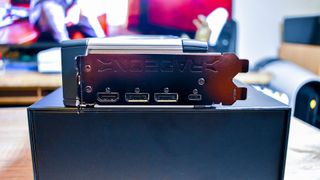
- Divisive, dated design
- Triple-fan cooling solution. Goodbye blowers!
- USB-C video out
Because this is the most powerful graphics card AMD has released in years, it had to rethink the cooler. The blower-style cooler on the card in our AMD Radeon RX 5700 XT review just wouldn't cut it on a graphics card of this caliber, so AMD opted for a 2.5-slot triple fan option. This is why temperatures stay manageable under default settings, and if you want to dive into something like MSI Afterburner, you can get even better temperatures out of it by messing around with the fan curve.
There's also a good assortment of outputs on the Radeon RX 6800 XT. You get two DisplayPort, one HDMI 2.1 and USB-C, which should cover basically any modern display on the market. We're just thankful AMD didn't drop USB-C like Nvidia did. For power, there are two 8-pin power connectors at the back of the card.
The AMD Radeon RX 6800 XT looks very much like a capital-g Gaming product. The side of the graphics card, what you'll actually see when it's mounted in your PC case, is all black with red trim and the Radeon logo in white lettering – lettering which lights up red, obviously.
The front of the graphics card has a silver strip which surrounds the three fans, each of which has an 'R' logo, which stands for Radeon. On the back, that silver strip is wider, and leaves the back of the GPU exposed through the backplate, something that doesn't exactly scream "premium," but ultimately doesn't matter much.
Some folks are definitely going to find the AMD Radeon RX 6800 XT design divisive, especially given that the black and red gaming aesthetic is a bit out of date in 2020. PC cases these days almost universally have a tempered glass side panel, so a graphics card that looks like it came straight out of 2005 is a bit of a hard pill to swallow for anyone that wants to show off their rig. This will depend entirely on your taste, though, and likely won't even be important to a vast majority of people.
- Design: 3 / 5
AMD Radeon RX 6800 XT: Performance






























- Excellent DirectX11 Performance
- Lags behind RTX 3080 at 4K, especially with ray tracing activated
- AMD is finally competitive with ray-tracing Nvidia cards, at least
This is the system we used to test the AMD Radeon RX 6800 XT:
CPU: AMD Ryzen 9 5950X (16-core, up to 4.9GHz)
CPU Cooler: Cooler Master Masterliquid 360P Silver Edition
RAM: 64GB Corsair Dominator Platinum @ 3,200MHz
Motherboard: ASRock X570 Taichi
SSD: ADATA XPG SX8200 Pro @ 1TB
Power Supply: Corsair AX1000
Case: Praxis Wetbench
Performance for the AMD Radeon RX 6800 XT is a complicated story. There are some cases where it can wipe the floor with the RTX 3080, but most of the time, and likely going forward, it has a really tough matchup against Nvidia's flagship.
Where the Radeon RX 6800 XT is strongest is in DirectX 11. For instance, in the 3DMark Fire Strike Ultra test, which is a DX11 test made for 4K-level performance, the RX 6800 XT scores 12,209 points to the RTX 3080's 11,034. That's a 10% performance advantage for AMD at the same price point.
There are some games where this difference is illustrated, too. In Grand Theft Auto V at 4K, the Radeon RX 6800 XT is around 8% faster than the RTX 3080, and it's even 9% faster in Assassins Creed: Odyssey. But, that's not the same story across the board.
The Nvidia GeForce RTX 3080 beats the AMD Radeon RX 6800 XT by a whopping 12% at 4K with ray tracing off. And, when you turn ray tracing on, that difference expands to 34%. That ray tracing performance? That's with DLSS disabled. If you turn on DLSS with the GeForce RTX 3080, you can get 65 fps at 4K with ray tracing enabled, up from the 47 fps on the same card without Nvidia's AI upscaling tech. Let's just say that AMD needs a meaningful answer to DLSS if it wants to really compete with Nvidia's ray tracing, because it was obviously not able to brute force its way to solid RT performance.
This is also reflected in the synthetic 3DMark Port Royal test. In this heavily ray tracing-focused test, AMD whiffs hard, scoring 8,541 points to the RTX 3080's 11,344, a 33% difference. When it comes to ray tracing, Nvidia is simply way ahead of AMD, and there's no way around that. But, hey, at least the AMD Radeon RX 6800 XT does support the tech, you're just going to want to play at 1440p if you want RT enabled.
All that being said, though, it is impressive that AMD is able to compete in this part of the market at all. It has been years since AMD has had this level of GPU, and we're happy to welcome it back into the fold. It's also important to remember that Nvidia didn't smash Intel after one generation of Zen – it took a while.
If AMD is able to keep pushing its high-end graphics and improving performance as much as the 6800 XT improves on the 5700 XT after just a year, we imagine Nvidia could be sweating. This isn't the graphics card that dethrones Nvidia's performance lead, but it is a graphics card that shows that AMD is very much back in the game, and we're definitely excited to see what the next generation of RDNA holds.
We even asked AMD, and it told us it "expects gamers will see stronger performance from the Radeon RX 6800 Series graphics cards in more modern games". So, we guess we'll wait and see.
- Performance: 4 / 5
Should you buy an AMD Radeon RX 6800 XT?
Buy it if...
You play a lot of DX11 games
The AMD Radeon RX 6800 XT is strongest in DirectX 11 games like Assassins Creed Odyssey and Grand Theft Auto V. If your go-to game is based on this API, its likely that you'll get stronger performance here than with the RTX 3080.
You're willing to mess around with your BIOS
With AMD Smart Access Memory (SAM) you can unlock up to 10% extra performance if you're willing to dig around in your BIOS. Not everyone will be comfortable doing this, though, and there's nothing wrong with that.
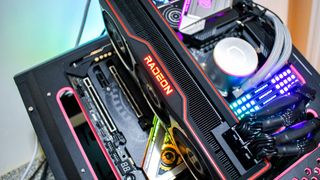
Don't buy it if...
You want ray tracing at 4K
Ray tracing performance on the RX 6800 XT is more than sufficient at 1440p, but if you want to turn those shiny graphics effects on at 4K, your money is better spent on an Nvidia card right now.
You play a lot of DirectX12 games
With current drivers, the AMD Radeon RX 6800 XT falls behind when it comes to DX12 performance, and it just so happens that will likely be the API behind most next-gen games.
You want Nvidia Broadcast or RTX I/O
Right now, Nvidia has the more fully-featured software stack. While AMD does have some useful features that can boost image quality, the lack of a next-generation-ready I/O API, or the AI noise and background remover, Nvidia's cards are better for people who also use their gaming PC for work.
Also Consider
Nvidia GeForce RTX 3080
Though its MSRP is slightly higher than the RX 6800 XT, you get substantial benefits for that money, like machine-learning-driven DLSS and substantially better creative workload performance. This is also one of the hardest graphics cards to find right now though, so only seriously consider this if you actually have the chance to buy one.
Read our full Nvidia GeForce RTX 3080 review
AMD Radeon RX 6800
While slightly less powerful than the RX 6800 XT, the RX 6800 is also a good bit cheaper than the XT variant, and both offer about the same performance-to-price ratio for most gaming and synthetic benchmarks, so those on a budget have a strong option here.
Read our full AMD Radeon RX 6800 review
Nvidia GeForce RTX 3070 Ti
While not as powerful on some benchmarks and in some games, the RTX 3070 Ti is a bit cheaper and comes with some extra Nvidia benefits that the RX 6800 XT doesn't have, so it's a solid trade off.
Read our full Nvidia GeForce RTX 3070 Ti review
AMD Radeon RX 6800 XT: Report Card
| Value | While the RX 6800 XT costs less than the RTX 3080 it is trying to compete with, it isn't that much cheaper, and the huge jump in price signals the end of AMD as a value champion for PC builders. | 3 / 5 |
| Features & Chipset | With the RX 6800 XT, AMD finally brings ray tracing to its graphics cards, which is huge. And while it didn't launch with graphics upscaling technology, it has since released AMD Radeon Super Resolution, helping level the playing field with Nvidia. | 4 / 5 |
| Design | The reference card for the Radeon RX 6800 XT is not very attractive, to be honest, though the move to a triple-fan cooling design is welcome. | 3 / 5 |
| Performance | The gaming performance of the RX 6800 XT is definitely impressive, and at times provides very healthy competition to the RTX 3080, but its ray tracing capabilities and lack of tensor cores really do hold it back from truly going toe-to-toe with Team Green. | 4 / 5 |
| Total | While this is one of the best cards AMD has ever produced, there are still a few too many shortfalls to really let it compete with the best Nvidia cards. | 3.5 / 5 |
- First reviewed May 2021
Jackie Thomas is the Hardware and Buying Guides Editor at IGN. Previously, she was TechRadar's US computing editor. She is fat, queer and extremely online. Computers are the devil, but she just happens to be a satanist. If you need to know anything about computing components, PC gaming or the best laptop on the market, don't be afraid to drop her a line on Twitter or through email.
- John LoefflerComponents Editor

SpaceX and Apple reported spat could spell bad news for Starlink and your iPhone’s satellite communication features

Security firm Check Point confirms data breach, but says users have nothing to worry about

American cyber brass calls for retaliatory strikes against China, but is the US really ready?
